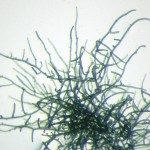Lien vers Pubmed [PMID] – 29728380
Appl. Environ. Microbiol. 2018 Jun;84(13):e00425-18
Cyanobacteria can synthesize alkanes and alkenes, which are considered to be infrastructure-compatible biofuels. In terms of physiological function, cyanobacterial hydrocarbons are thought to be essential for membrane flexibility for cell division, size, and growth. The genetic basis for the biosynthesis of terminal olefins (1-alkenes) is a modular type I polyketide synthase (PKS) termed olefin synthase (Ols). The modular architectures of Ols and structural characteristics of alkenes have been investigated only in a few species of the small percentage (approximately 10%) of cyanobacteria that harbor putative Ols pathways. In this study, investigations of the domains, modular architectures and phylogenies of Ols in 28 cyanobacterial strains suggested distinctive pathway evolution. Structural feature analyses revealed 1-alkenes with three carbon chain lengths (C, C and C). In addition, the total cellular fatty acid profile revealed the diversity of the carbon chain lengths, while the fatty acid feeding assay indicated substrate carbon chain length specificity of cyanobacterial Ols enzymes. Finally, analyses suggested that the N-terminus of the modular Ols enzyme exhibited typical characteristics of a fatty acyl-adenylate ligase (FAAL), suggesting a mechanism of fatty acid activation via the formation of acyl-adenylates. Our results shed new light on the diversity of cyanobacterial terminal olefins and a mechanism for substrate activation in the biosynthesis of these olefins.Cyanobacterial terminal olefins are hydrocarbons with promising applications as advanced biofuels. Despite there being a basic understanding of the genetic basis of olefin biosynthesis, the structural diversity and phylogeny of the key modular olefin synthase (Ols) have been poorly explored. An overview of the chemical structural traits of terminal olefins in cyanobacteria is provided in this study. In addition, we demonstrated by fatty acid feeding assays that cyanobacterial Ols enzymes might exhibit substrate carbon chain length specificity. Furthermore, by performing bioinformatic analyses, we observed that the substrate activation domain of Ols exhibited typical features of a fatty acyl-adenylate ligase (FAAL), which activates fatty acids by converting them to fatty acyl-adenylates. Our results provide further insight into the chemical structures of terminal olefins and further elucidate the mechanism of substrate activation for terminal olefin biosynthesis in cyanobacteria.




